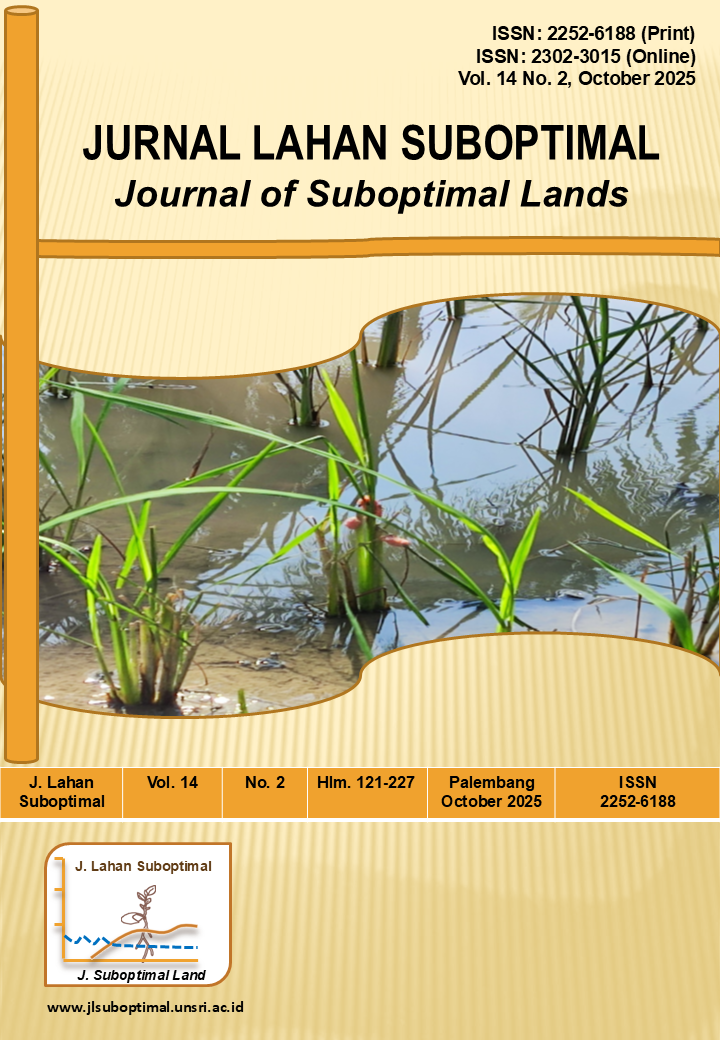Utilization of coal burning waste fly ash as a soil improving material in red yellow podsolic soil
DOI:
https://doi.org/10.36706/jlso.14.2.2025.727Keywords:
ameliorant, coal burning, fly ash, red yellow podzolic soil, wasteAbstract
This research aimed to characterize and test the chemical properties of red-yellow podzolic soil and fly ash. The experiment was conducted using polybags with various dosage levels of 2 types of red-yellow podzolic soil, as well as fly ash. Dolomite was used as a control. The experiment used 3 types of experiments with 3 repetitions on the soil (A1=10 g of fly ash /polybag, A2=15 g of fly ash/polybag, A3=20 g of fly ash/polybag, and A0=10 g of dolomite/polybag as a control). The results showed that the application of fly ash waste can increase the pH of podzolic soil. There was an increase in K-dd from 0.34 to 1.36. Al-dd analysis of the addition of fly ash ameliorant Al-dd levels decreased quite significantly with an average of 5.26‒7.16. Al-dd levels were very low in treatment A3 with the addition of 20 g/polybag. H-dd analysis on Red and Yellow Podzolic soils resulted in an increase in the initial H-dd of the soil from 0.4 to 4.61‒7.16. The highest H-dd was in A2 with the addition of 15 g of fly ash/polybag and the lowest H-dd iss in treatment A3 with the addition of 20 g/polybag.
References
Aida, E. R., Lisha, S. Y., & Puty, Y. (2018). Utilization of coal ash waste (Fly Ash) at PLTU ombilin as a coagulant. Jurnal Pendidikan Teknologi Kejuruan, 1(3), 125–131. https://doi.org/10.24036/jptk.v1i3.2223
Ahmed, T., Noman, M., Qi, Y., Shahid, Hussain, Ayesha, M., Xu, Hasan, Negm, S., El-Kott , Yao, Y., Qi, X., & Li, B (2023). Fertilization of microbial composts: a technology for improving stress resilience in Plants. Plant Journal, 12(20), 35‒50. https://doi.org/10.3390/plants12203550
Fauziah, N., Iskandar, & Djajakirana, G. (2022). The effect of cow manure compost and fly ash-bottom ash (FABA) addition on the chemical properties of sandy soil and tomato growth.. Journal of Soil And Environmental Science. 24 (1), 1‒5. https://doi.org/10.29244/jitl.24.1.1-5
LGrimme, H., & Mutsher, H. (1985). Potassium in the agricultural systems humid tropics. In Proceedings of the 19th Colloquium of the International Potash Institute Held in Bangkok, Thailand. Quoted by Helmi Abdillah and Muhammad Aldi. 2020. Application of rubber solid waste in red-yellow podzolic soil to macronutrien availability and improvement of soil physical properties. EnviroScienteae, 16 (2), 264–275. https://doi.org/10.20527/es.v16i2.9658
He, H., Dong, Z., Peng, Q., & Wang, X. (2017). Impacts of coal fly ash on plant growth and accumulation of essential nutrients and trace elements by alfalfa (Medicago sativa) grown in a loessial soil. Journal of Environmental Management, 197, 428‒439. https://doi.org/10.1016/j.jenvman.2017.04.028
Hakim, N., Nyakpa, M. Y., lubis, A. M., Nugraha, S. G., Saul, M. R., Diha, M. A., Hong, G. B., & Bailey, H. H. (1986). Basics of soil science. Universitas Lampung, Quoted by Susance Isir, Zetly E. Tamod, Joice M.J. Supit. (2022). Identification of soils chemical properties on land of shallots plantation (Allium Ascalonicum, L.) In Talikuran Village Remboken District Minahasa Regency. Soil environmental Journal, 22(1), 6‒11. https://doi.org/10.35791/se.22.1.2022.38911
Karo, H. Y. K., Pramono, N., Wahyuni, S., Mashoedi, I. D., & Latifah, L. (2017). Lavender (Lavandula angustifolia) aromatherapy as an alternative treatment in reducing pain in primiparous mothers in the active first stage of labor. Belitung Nursing Journal, 3(4), 420–425. https://doi.org/10.33546/bnj.159
Kinasti, R. M. A., & Notodisurzo, D. N. (2017). Utilization of coal burning waste (bottom ash) at the suralaya power plant as a planting media in an effort to reduce environmental pollution. Jurnal Kajian Ilmu dan Teknologi. 69(02), 129–138. https://doi.org/10.33322/kilat.v6i2.129
Nji, L. T. (2014). Fly ash: Overview. http://lauwtjunnji.weebly.com/fly-ash-overview.
Nursanti, D. F., Defrian, & Novriani (2021). Growth and yield of okra applied with a bio-stimulant from golden apple snails extracts and fertilizer on ultisol. Jurnal Lahan Suboptimal : Journal of Suboptimal Lands, 10(1), 37‒45. https://doi.org/10.36706/JLSO.10.1.2021.515
Sudaryono. (2016). Fertility Level Of Ultisol Soil In Sangatta Coal Mining Land, East Kalimantan. Jurnal Telnologi Lingkungan, 10 (3), 337–346. https://doi.org/10.29122/jtl.v10i3.1480
Wong, J. W. C., & Su, D. C. (1997). Reutilization of coal ash and sewage sludge as an artificial soil mix: Effect of preincubation on soil physico-chemical properties. 145 (2014) https://doi.org/10.1016/S0960-8524(96)00174-5. In Shaheen, S. M. Hooda, P. S., Tsadilas, C. D (2014). Opportunities and challenges in the use of coal fly ash for soil improvements e A review. Elsevier, 249‒267. https://doi.org/10.1016/j.jenvman.2014.07.005
Notohadiprawiro, T. (1968). A contribution to the identification of red-yellow. podzolic soils found in the tropics. Jurnal Penelitian Tanah, 6(1), 32–45.
Rhazista, N. (2013). Coal combustion waste as soil amelioratnat and source of nutrients: case study for sunflower (Helianthus Annus). Jurnal Riset Geologi dan Pertambangan, 23(1), 61–72. https://doi.org/10.14203/risetgeotam2013.v23.70
Subardja, D., Ritung, S., Anda, M., Sukarman., Suryani, E., & Subandiono, R. E. (2016). Technical guidelines for national soil classification. 2nd edition. center for agricultural land resources research and development, agency for agricultural research and development. Bogor. 60 pp.
Sparks, D. L. (1987). Potassium dynamics in soils. springer-verlag new York, Inc. Advances in Soil Science, 6: 5–8 in Astria. In P. & R. Suntari. (2017). Application of urea and cocoa husk compost to increase availability and absorption of N,P,K and mustard greens production on Inceptisol Tulungrejo, Batu. Journal of Soil and Land Resources, 4(1), 82–87. https://doi.org/10.21776/ub.jtsl.2017.004.01.15
Schroeder, D. (1984). Soil fact and concepts (translate from German). PA. Gething International Potash Institute, Bern. Quoted by Suatika & Kasno (2021). Nutrition management on irrigated rice fied to increase maize productivity. 1st international conference on sustainable tropical land management. Earth and Environmental Science 648 (2021) 012076. https://doi.org/10.1088/1755-1315/648/1/012076
Soil Research Institute. (2009). Chemical analysis of soil, plants, water, and fertilizers. Bogor: Agricultural Research and Development Center, Department of Agriculture..
Wardhani, E., Sutina, M., Herlina, A., D. (2012). Evaluation of the utilization of fly ash as a planting stock for tomato plants (Solanum Lycopersicum). ITN Bandung Technology Journal, 16 (1), 44–56.
Downloads
Published
How to Cite
Issue
Section
License
Copyright (c) 2025 Asia Afriyani Afriyani

This work is licensed under a Creative Commons Attribution-NonCommercial-ShareAlike 4.0 International License.













